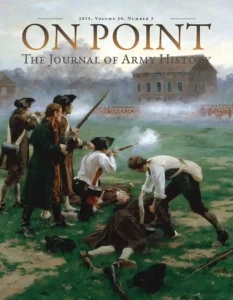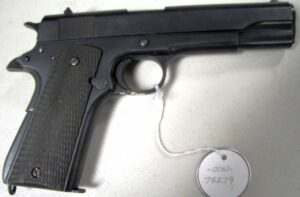Written By: Lieutenant Colonel Clayton R. Newell, USA-Ret.

The small town of Fort Defiance is located in northeastern Arizona at the mouth of Canyon Bonito, or Beautiful Canyon, so named by Spanish explorers because of the green, grassy fields in the area. Before the first Americans arrived it was a popular place for Mexicans and Navajos to meet and conduct horse races. With the end of the Mexican War and the Treaty of Guadalupe Hidalgo in February 1848, the Navajo homeland became part of the United States, and it was not long before Americans arrived to take possession of it.

The first known American to visit Canyon Bonito was Brevet Lieutenant Colonel John M. Washington, 3d Artillery, who passed through the area after concluding the Navajo Treaty of 1849. After the negotiations for the treaty, however, soldiers escorting Washington sowed the seeds for future conflict with the Navajos when they mortally wounded Narbona, a prominent peace leader, during a dispute over a stolen horse. As a result of the killing, his son-in-law, Manuelito, who later became a highly respected Navajo chief, harbored a deep mistrust of Americans.

Two years after Washington’s visit, Major Electus Backus, 3d Infantry, established Fort Defiance in September 1851 at the direction of Lieutenant Colonel Edwin Vose Sumner, commander of the Ninth Military Department (New Mexico Territory), who wanted to maintain a visible Army presence among the Navajos. Under Backus’s supervision the soldiers used sod and logs to construct a traditional frontier fort with buildings arranged around a large rectangular parade ground.
The soldiers used the grassy meadow surrounding the post for grazing their horses and cattle. Although it was a pleasant location, the site of the new fort was of concern to some officers who worried that it was too close to the almost vertical sides of the canyon, offering a potential advantage to attackers. Many of the troops assigned to garrison the post echoed those concerns when they referred to the fort as “Hell’s Gate.”

Initially, the Navajos tried to ignore the new fort, although they were annoyed when the Army prevented them from using the most desirable pasture lands for grazing their horses and sheep. As time went by, however, there were an increasing number of skirmishes between the soldiers and the Navajos. The situation eventually came to a head in July 1858 when a Navajo warrior who came on the post for trading shot an arrow into the back of a black servant, mortally wounding him. The Indian had apparently recently quarreled with his wife and was in a vindictive mood, which according to Indian custom made the action acceptable because it cleansed the warrior’s heart.
Brevet Major William T.H. Brooks, 3d Infantry, the post commander, however, did not see it that way and demanded that the Indians surrender the perpetrator. When after several months the demand was not met, Lieutenant Colonel Dixon Miles, 3d Infantry, assembled 307 men from the Regiment of Mounted Riflemen and the 3d Infantry and set out to find the guilty warrior in September. Dixon’s expedition was unsuccessful in finding the culprit, but it did aggravate the already tense relations between the Army and the Navajos.
In January 1860, a band of warriors ambushed a wagon train on its way to resupply Fort Defiance, and the next month another group attacked twenty-eight men who were guarding the post’s herd of beef cattle. The deteriorating situation culminated on 30 April when Manuelito assembled more than 1,000 Navajo warriors, attacked the fort before dawn, and captured several of the post’s outer buildings.
Surprised by the attack, Brevet Major Oliver L. Shepherd and Companies B, C, and E of the 3d Infantry did not immediately respond in the darkness, but at daybreak they mounted a counterattack, cleared the occupied buildings, and with a series of infantry charges drove the attackers back into the foothills. Casualties were light on both sides. One soldier was killed and two were wounded; Navajo losses were approximately twelve killed or wounded.
Before the Army could mount another offensive, its efforts to bring the Navajos under control were interrupted in 1861 by the beginning of the Civil War. When a Confederate brigade of Texans threatened to invade the New Mexico Territory, Colonel Edward R.S. Canby, 19th Infantry, the military department commander, decided to abandon some outlying posts and consolidate his forces to defend the territory.
He therefore directed Companies A, B, E, and H of the 5th Infantry, which had recently replaced the 3d Infantry at Fort Defiance, to abandon the post and move to Fort Fauntleroy in May and June. Two years later, in late 1863, with the Confederate threat to the territory eliminated, military authorities in New Mexico once again turned their attention to subduing the Navajo threat.

Colonel Christopher “Kit” Carson and the 1st New Mexico Infantry reoccupied the post at Canyon Bonito and renamed it Fort Canby. The fort served as the headquarters for Carson’s scorched earth campaign during which he burned Navajo homes and fields and killed or confiscated their livestock. In January 1864, he sent some 400 officers and men into Canyon de Chelly to attack Manuelito and the Navajos in their last stronghold. The warriors harassed the soldiers as they entered the canyon, but eventually the cold and starving Indians were forced to surrender and move to Fort Canby, although Manuelito and a small band managed to elude capture for another two years.
By mid-March 6,000 Navajos had surrendered. In what the Navajos call the “Long Walk” groups of several hundred to a thousand were forced to march across the high desert some 300 miles to Bosque Redondo, an old Spanish trading post in New Mexico, where they were held as prisoners until 1868. Eventually more than 8,000 men, women, and children set out on the Long Walk—about three fourths of the tribe—and hundreds of them perished along the way. The movement of the tribe to Bosque Redondo removed any further threats from the Navajos, so in October 1864, the Army abandoned the Fort Canby.
After the Civil War, as the country turned its attention to settling the West, Congress established a Peace Commission “to establish peace with certain hostile Indian tribes,” including the Navajos still being held in captivity in New Mexico. In May 1868, two of the commissioners, one of whom was Lieutenant General William T. Sherman, arrived at Bosque Redondo where they negotiated the Navajo Treaty of 1868 that finally allowed the remaining Indians to return to their traditional homeland. Among the Navajo signers was Manuelito who had been interred at Bosque Redondo since his surrender in 1866. The Long Walk Home included 7,304 Navajos, 1,500 horses and mules, and 2,000 sheep, along with fifty Army wagons and a cavalry escort.
As part of the resettlement, Fort Defiance became the agency for the new Navajo Reservation. In 1936, the agency moved to Window Rock, Arizona, which later became the capital of the Navajo Nation, but the old fort continued to provide medical and other services for the reservation. The Fort Defiance Medical Center opened in 1938 as the first medical facility on the reservation, and today the Fort Defiance Indian Hospital is a 245,000-square-foot, state of the art rural hospital.
In 1870, the House Military Affairs Committee commissioned Seth Eastman, a retired Army brigadier general, to paint a series of Army forts, stipulating that they not include battle scenes. He produced seventeen canvases, one of which was Fort Defiance, the only post in the Southwest that he painted. While it is not clear if Eastman actually ever visited the post, he was stationed at Fort Crittenden, Utah, in the 1850s when he was on active service with the 5th Infantry.

Part of the regiment was stationed at Fort Defiance at the time, and he may have visited there at some point. Eastman’s painting shows the high canyon walls that some officers thought threatened the defense of the fort, although the barren landscape does not reflect the lush grazing land that actually surrounded the post. In consonance with the Congressional guidance, Eastman depicted Fort Defiance as a peaceful place typical of western Army posts in the nineteenth century.



